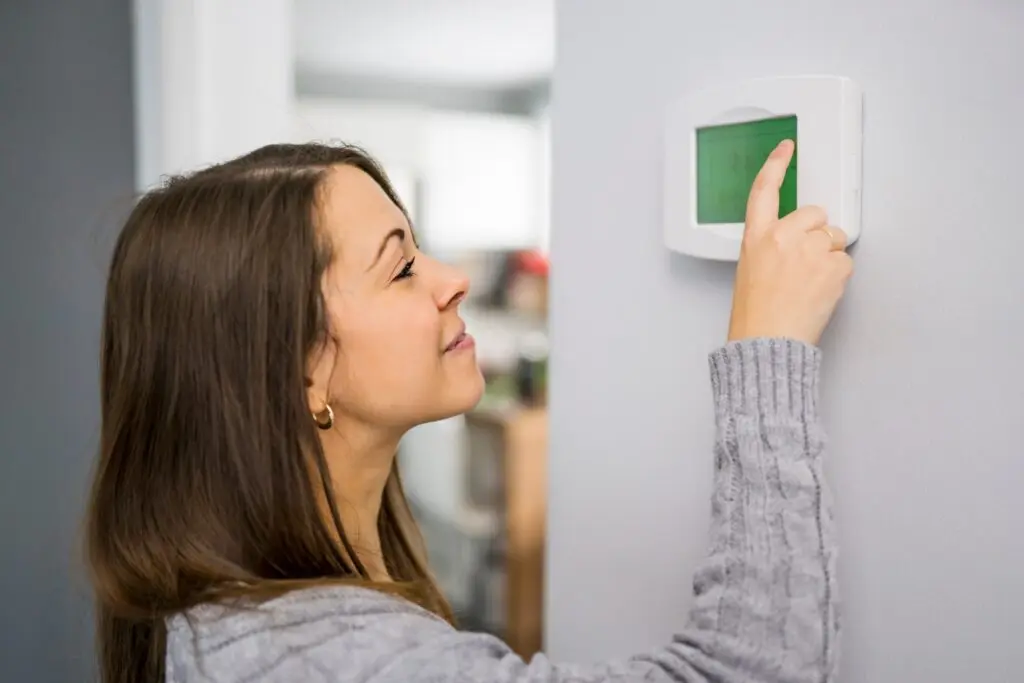When it comes to saving money on your gas or electric bill, few things are more effective than these recommended thermostat settings.
Some homes have multiple thermostats in multiple zones, all with unique settings and features. This guide focuses on the most basic function of all thermostats: temperature control.
Our suggestions will help you heat and cool your home in an energy-efficient way.
The result: big energy savings for every season!
How do thermostats work?
Thermostats work by monitoring the temperature of their environment.
If the indoor temperature falls below a set point and the thermostat is set to “heating,” it signals your heating system to kick on, warming things up.
Likewise, if your system is set to “cooling” and temps go higher than the setting on your thermostat, the AC will kick on.
Why are thermostat settings important?
According to Energy.gov, it’s possible to save as much as 10% on your annual heating and cooling bill by simply adjusting your thermostat.
In fact, if you keep the temperature in your home lower for at least eight hours a day, you could save as much as 1% on your energy bill per degree. Perhaps it goes without saying, but these savings add up fast!
What are the best thermostat settings by season?
Depending on the time of year and your climate, you’ll need to set your thermostat differently. A general rule of thumb is to set the temperature lower on colder days and higher on hotter days.
Winter Settings
Set your thermostat to 68°F in the winter during the hours you’re at home and awake. To save more money on your heating bill, drop the temperature even lower while you’re sleeping or out of the house.
Sleep Foundation suggests the best bedroom temperature for sleeping is roughly 65°F. This means you can drop your thermostat settings further for greater savings at night – anywhere from 67°F to as low as 60°F. Of course, this depends on your preferences and the other people in your household.
If you have any young children or infants in your home, a slightly warmer temperature may be in order. WebMD writes that the ideal temperature for babies is between 68°F and 72°F.
If you prefer a warmer temperature of 70°F to 72°F, consider wearing extra layers on colder days. Even just a few degrees will have a significant impact on your winter heating bill. Anything you can do to keep the settings lower during these months will benefit your bank account.
Summer Settings
In the summer, you want higher settings for your thermostat. Higher temperature settings on the thermostat mean your AC will run less. 72°F is a reasonable temperature setting for the warmer months, but there’s even more you can do to save on cooling costs.
Follow similar rules for summer as you do in the winter – only in the other direction. Set your thermostat seven to 10 degrees higher while you’re away from home.
If you find yourself comfortable in hotter weather, consider dressing lighter and keeping the temps between 72°F and 78°F while you’re home.
Spring & Fall Settings
Keep tabs on the weather and shut off your heating and cooling entirely when it’s nice out. The longer you can keep your HVAC system off, the less energy it will consume. You may need to pay more attention to the weather, as it can be less consistent in the Spring or Fall.
How else can I save money on my heating and cooling?

There are plenty of other ways to save more money on your heating and cooling through your thermostat.
Programmable Thermostats
Programmable will adjust your settings in order to save you money on cooling and heating costs. With a programmable thermostat, you’ll play a greater role in managing these settings.
You can set a programmable thermostat to adjust automatically on different days at different times. If you and your family have a regular schedule and you want more control over your heating and cooling system, consider upgrading to a programmable thermostat.
Smart Thermostats
Smart thermostats are a bit more intuitive than programmable options. They monitor how you use them and eventually take over these settings changes automatically over time.
Beyond their learning capabilities, many smart thermostats feature additional features and reporting, allowing you to track and monitor your energy use over time. This can help you refine your settings and lifestyle even further for more savings.
Thermostat Positioning
The placement of your thermostat matters when it comes to heating and cooling your home efficiently.
CNET writes that the best thermostat location is on an interior wall in a main room you use often – basically, someplace where you spend a lot of time. It should also be unobstructed by furniture or other objects.
Finally, you want to keep thermostats away from air vents, doors, windows, direct sunlight, hallways, and your kitchen.
If you’re concerned about the positioning of your home thermostat(s), consult an HVAC expert. They’ll be able to help you figure out the best place for these sensors and can even help you upgrade to a smart or programmable model.
Home Warranty Coverage
To save money on unexpected repair costs in the case of a breakdown, invest in a home warranty. Even if you have an old HVAC unit, a home warranty can help cover the costs of repair or replacement if your heating and cooling system or thermostat is having issues.
Interested in a home warranty for your heating and cooling system?
If you’ve been thinking about a home warranty, now is the time to get one. Beyond covering your heating and cooling system, home warranties cover other appliance and home system breakdowns.
Learn what a home warranty covers and see how you can save money with a free quote. Call us anytime at 800-670-8931.
Related Articles:

